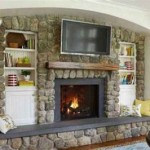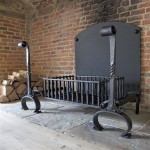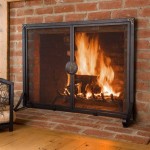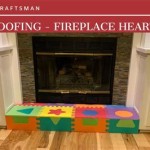Fireplace Heater With Blower: A Comprehensive Guide
Fireplace heaters with blowers represent a modern approach to supplemental heating, combining the aesthetic appeal of a traditional fireplace with the efficiency of forced-air heating. These units are designed to distribute heat more effectively throughout a room, addressing a common drawback of traditional fireplaces, which often radiate most of their heat directly in front of the unit, leaving other areas colder.
This article will delve into the functionalities, benefits, types, and considerations associated with fireplace heaters equipped with blowers. This information is intended to provide a comprehensive understanding of the technology and its application in residential heating.
Understanding the Functionality of a Fireplace Heater With Blower
A fireplace heater with blower fundamentally operates on the principles of convection and radiation. The heating element, which can be electric resistance coils, gas burners, or even a wood-burning fire, generates heat. This heat is then radiated outwards, warming objects and people directly in front of the fireplace. However, the integrated blower enhances the convective heat transfer process.
The blower, essentially a fan, draws cooler air from the room, passes it over the heated element or firebox, and then expels the warmed air back into the room. This forced-air circulation allows for a more uniform distribution of heat throughout the space. Without a blower, the natural convection cycle (warm air rising and cool air sinking) would be the primary method of heat distribution, which is often slower and less effective at reaching all corners of the room.
The blower's speed is often adjustable, allowing users to control the rate of heat distribution and the intensity of the airflow. Higher blower speeds will result in faster and more widespread heating, while lower speeds will provide a gentler, less noticeable airflow. Some advanced models even feature automatic blower speed adjustment based on the temperature of the heating element or the room itself.
The location of the blower is also a factor in its effectiveness. Blowers positioned at the bottom of the fireplace heater tend to draw in the coolest air from the floor, maximizing the temperature difference between the intake and exhaust air and improving heating efficiency. Top-mounted blowers, while less common, can provide good air circulation as well, although they may be slightly less efficient at capturing the coolest air.
Benefits of Using a Fireplace Heater With Blower
The advantages of incorporating a blower into a fireplace heater are numerous, particularly in comparison to traditional fireplaces or radiant heaters. These benefits are generally related to improved heating efficiency, comfort, and control.
Increased Heating Efficiency: The primary benefit is the enhanced distribution of heat. By actively circulating warm air, a blower helps to eliminate cold spots and maintain a more consistent temperature throughout the room. This allows the heater to warm the space more quickly and efficiently, reducing the amount of energy required to maintain a comfortable temperature. This is particularly relevant in larger rooms or rooms with poor insulation.
Improved Comfort: The even distribution of heat contributes significantly to overall comfort. Without a blower, the area directly in front of the fireplace can become excessively warm, while areas further away remain relatively cold. The blower mitigates this temperature disparity, creating a more pleasant and comfortable environment. Furthermore, the adjustable blower speed allows users to fine-tune the airflow to their preferences, minimizing drafts and maximizing comfort.
Enhanced Control: Many fireplace heaters with blowers offer adjustable thermostat settings and blower speed controls. This level of control allows users to precisely manage the room temperature and airflow, optimizing both comfort and energy consumption. Some models even include programmable timers, enabling users to schedule heating cycles to coincide with their daily routines. These features provide a level of convenience and control that is typically not available with traditional fireplaces.
Supplemental Heating: Fireplace heaters with blowers are typically designed for supplemental heating, rather than as a primary heating source for an entire home. This means they are best suited for warming specific rooms or areas, rather than replacing the central heating system. Using a fireplace heater with blower as a supplemental heat source can help to reduce the load on the central heating system, potentially saving energy and lowering heating costs.
Aesthetic Appeal: Despite their functional benefits, fireplace heaters with blowers retain the aesthetic appeal of traditional fireplaces. They can create a warm and inviting atmosphere, adding a touch of ambiance to any room. The visible flames, whether real or simulated, can be particularly comforting and relaxing.
Types of Fireplace Heaters With Blowers
Fireplace heaters with blowers come in various forms, each with its own set of advantages and disadvantages. The choice of which type to use depends on factors such as personal preferences, budget, and the specific heating requirements of the space.
Electric Fireplace Heaters With Blowers: These are arguably the most common type of fireplace heater with blower. They utilize electric resistance coils to generate heat, which is then circulated by the blower. Electric models are generally easy to install, requiring only a standard electrical outlet. They are also relatively safe, as they do not produce any open flames or combustion byproducts. However, their heating capacity may be limited compared to gas or wood-burning models, and they can be more expensive to operate due to electricity costs.
Gas Fireplace Heaters With Blowers: These units burn natural gas or propane to generate heat. They typically offer higher heating output than electric models and can be more economical to operate, depending on the price of gas. Gas fireplace heaters with blowers require professional installation to connect to a gas line and ensure proper venting of combustion gases. They also require regular maintenance to ensure safe and efficient operation.
Wood-Burning Fireplace Inserts With Blowers: These inserts are designed to be installed inside existing masonry fireplaces. They improve the efficiency of wood-burning fireplaces by creating a sealed combustion chamber and forcing air circulation with a blower. Wood-burning inserts with blowers can provide significant heating output and can be a sustainable heating option if wood is readily available. However, they require regular maintenance, including cleaning the chimney and removing ashes.
Ethanol Fireplace Heaters With Blowers: These fireplaces burn ethanol, a renewable fuel source, to produce heat. They do not require venting, making them a convenient option for apartments or homes without a chimney. Ethanol fireplace heaters with blowers typically offer a smaller heating capacity than gas or wood-burning models. They are also more expensive to operate, as ethanol fuel can be costly. Despite their limited heating capacity, they can still enhance the look and feel of a space.
Infrared Fireplace Heaters With Blowers: These heaters use infrared technology to heat objects and people directly, rather than heating the air. They claim to provide more efficient heating by focusing the heat where it is needed most. Infrared fireplace heaters with blowers often include a blower to circulate the warm air and provide a more uniform heating effect. They are generally energy-efficient and safe to use, but their heating capacity may be limited by the size and output of the infrared emitters.
When selecting a fireplace heater, it's essential to consider the unit's BTU (British Thermal Units) rating. BTU measures the amount of heat the heater produces per hour. The appropriate BTU rating depends on the size of the room to be heated; a larger room will require a heater with a higher BTU rating. Also, it's essential to consider the heater's energy efficiency. More efficient models will use less fuel or electricity to produce the same amount of heat, resulting in lower operating costs.
Fireplace Heater 5 Tube W Blower

Spitfire Tube Fireplace Heaters Heater Blower Heating And Plumbing

Learn More About The Diffe Styles Of Fireplace Grate Heaters

Grate Heater Wikipedia

Spitfire Tube Fireplace Heaters In 2024 Heater Blower Wood Burning

Grate Heater With Masonry Fireplace Doors Customized

Costway 20 Freestanding Electric Fireplace Heater Stove W Thermostat Flame Effect Target

Williams 6502521a 65k Btu Fireplace Look Propane Room Heater 70 Afue

Costway 5118 Btu 28 5 In Unvented Electric Furnace Heater Ghm0082 The Home Depot

Auseo Electric Fireplace Heater 16 All Metal Frame Freestanding Stove 3d Flame Remote Control 500w 1500w Black Com
Related Posts








